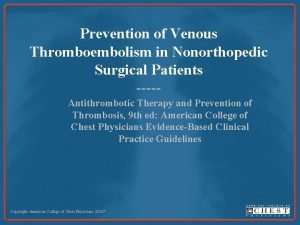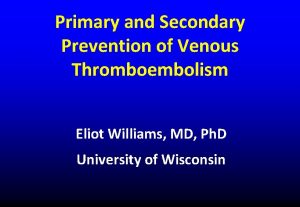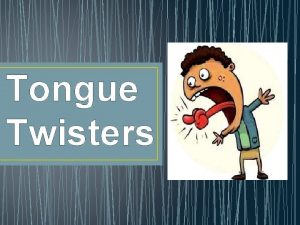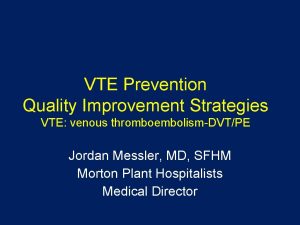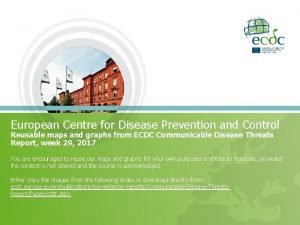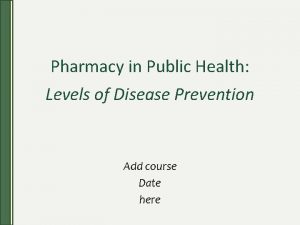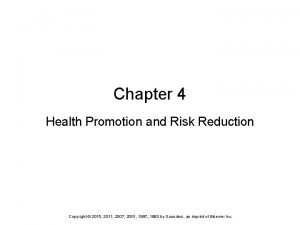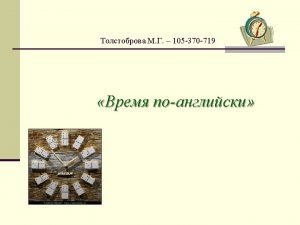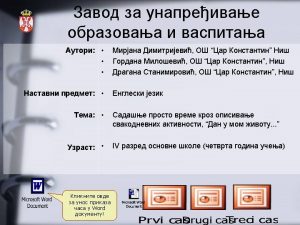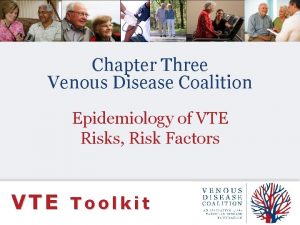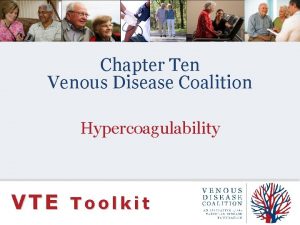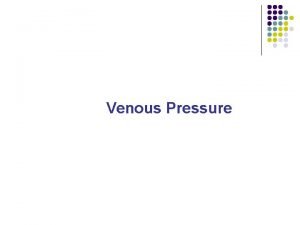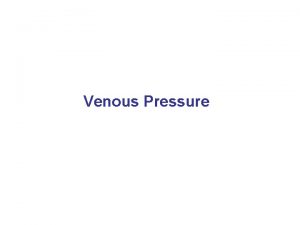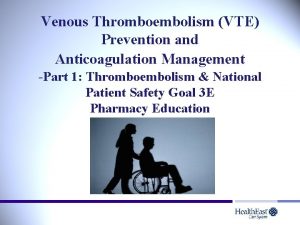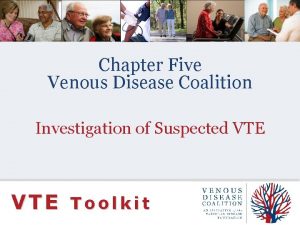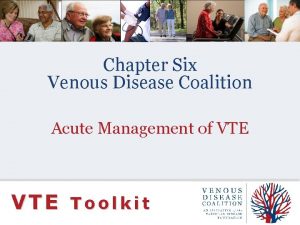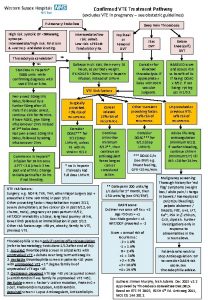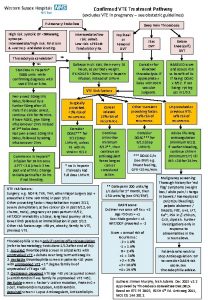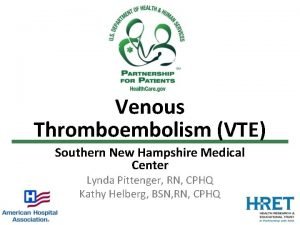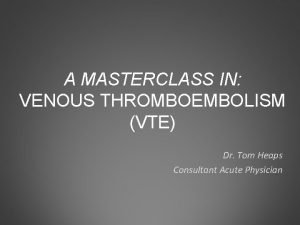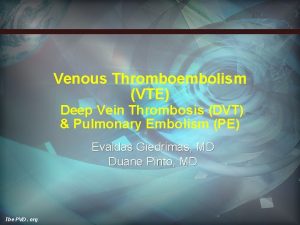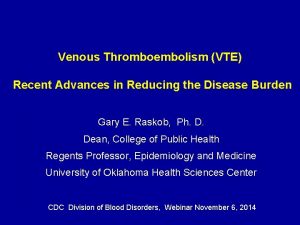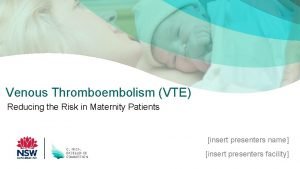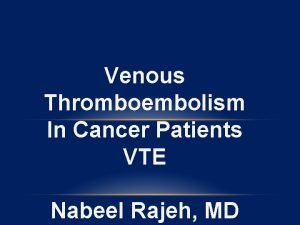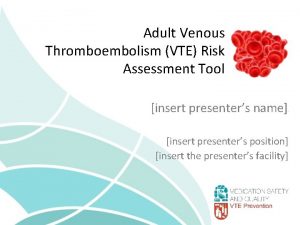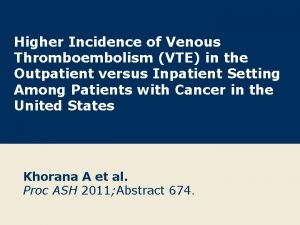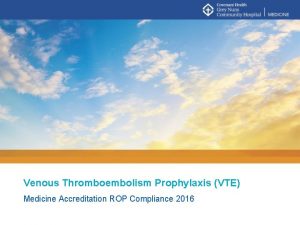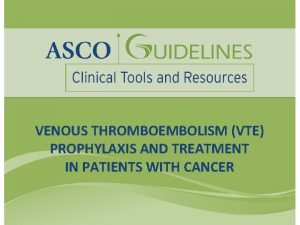Chapter Twelve Venous Disease Coalition Prevention of VTE













































- Slides: 45

Chapter Twelve Venous Disease Coalition Prevention of VTE Toolkit

Symptomatic VTE after Surgery • California Patient Discharge Database (N = 1, 653, 275) • VTE during surgical admission or within 3 months • Thromboprophylaxis data was not available Malignant disease Benign disease Hip replacement Craniotomy Knee replacement Coronary bypass Colectomy Hysterectomy TUR prostate Lap. cholecystectomy 2. 4% 2. 3% 1. 7% 1. 1% 0. 3% 0. 2% Craniotomy Colectomy Pneumonectomy Rad. Prostatectomy Hysterectomy Mastectomy 3. 6% 1. 7% 1. 6% 1. 5% 1. 2% 0. 4% White - Thromb Haemost 2003; 90: 446 VTE Toolkit

Postoperative VTE is Associated with Increased Mortality • 118, 258 surgical patients in 120 VA hospitals No 30 -day mortality 4. 4% Yes 16. 9% VTE p<0. 0001 • Symptomatic VTE is associated with significantly increased 30 -day mortality Gangireddy - J Vasc Surg 2007; 45: 335 VTE Toolkit

VTE is a Common Complication After Surgery (review of 7. 5 million discharges from 994 US hospitals) Postoperative DVT or PE: • 2 nd most common medical complication overall • 2 nd most common cause of excess length of stay • 3 rd most common cause of excess mortality • 3 rd most common cause of excess charges Zhan - JAMA 2003; 290: 1868 VTE Toolkit

Thromboprophylaxis Reduced Mortality after Hip Fracture 50 Years Ago!! (randomized trial) Symptomatic DVT Symptomatic PE Total deaths Autopsy - DVT - major PE Controls n=150 29 % 5% 28 % 83 % 41 % Phenindione* n=150 >> 3 %# >> 0 >> 17 % >> 14 % >> 10 % * from admission to ambulation (~5 weeks); PT 25 -40 sec # all after phenindione stopped Sevitt & Gallagher – Lancet 1959: 2: 981 VTE Toolkit

Low Dose Heparin Reduced DVT in 46 RCTs of Surgical Patients (n=15, 598) 25 15 Risk Reduction 59 % 10 9% 20 % 22 % 5 0 DVT Collins – NEJM 1988; 318: 1162 VTE Toolkit Control Low dose heparin

Reduction in DVT Correlated with Reduction in Fatal PE in 46 RCTs of 16, 000 Surgical Patients 25 15 Risk Reduction 59 % 10 9% 20 % 22 % 5 0 Control Low dose heparin Risk Reduction 63% 0. 8 % 0. 3 % DVT Fatal PE Collins – NEJM 1988; 318: 1162 VTE Toolkit

Prevention of Venous Thromboembolism 1986 1989 1992 1995 1998 2001 2004 Chest – June 2008 VTE Toolkit

Thromboembolism Risk Groups 8 th ACCP Guidelines on the Prevention of VTE • General surgery • Vascular surgery • Gynecologic surgery • Urologic surgery • Thoracic surgery • Bariatric surgery • Laparoscopic surgery • Coronary bypass surgery • Hip arthroplasty • Knee arthroscopy • Hip fracture surgery VTE Toolkit • Spine surgery • Lower extremity injuries • Neurosurgery • Major trauma • Spinal cord injuries • Burn patients • Medical patients • Cancer patients • Central venous catheters • Critical care patients • Long distance travel Geerts – Chest 2008; 133: 381 S

8 th ACCP Guidelines on Antithrombotic Therapy 1. 2 VTE Prophylaxis Policy 1. 2. 1 We recommend that every general hospital develop a formal, active strategy that addresses the prevention of VTE [Grade 1 A] Geerts – Chest 2008; 133: 381 S VTE Toolkit

How Can VTE be Prevented in Hospitals? 1. Getting patients up and walking as early as possible helps. . . but this is not enough 2. Giving patients low doses of an anticoagulant every day VTE Toolkit

The Myth of Mobility and DVT • Immobility ALONE rarely results in DVT • Immobility does increase the risk of symptomatic VTE after another risk factor (surgery, trauma, acute medical illness, cancer, etc. ) • After another thrombosis insult, mobilization does NOT eliminate or substantially reduce the VTE risk for some time The duration of prophylaxis should not be determined by mobility status alone VTE Toolkit

Mechanical Methods of Prophylaxis ü Graduated compression stockings (medical grade stockings, ? TEDSTM ü Intermittent pneumatic compression devices (SCDs. TM, , leg squeezers) ü Foot pumps If used properly, these methods work in some patient groups, but They generally don’t work as well as anticoagulants, and They require a big effort to work at all VTE Toolkit

Mechanical Methods of Prophylaxis Who should receive mechanical prophylaxis? 1. Patients at high risk for bleeding 2. ? Along with an anticoagulant method to try to improve protection VTE Toolkit

Mechanical Methods of Prophylaxis 1. Ensure they fit properly 2. Start ASAP 3. Have on ~24 hours/day – only remove for leg washing and when patient is actually walking 4. Ensure optimal compliance 5. Only stop at discharge VTE Toolkit

Pharmacologic (anticoagulant) Methods of Prophylaxis 1. Low dose heparin / minidose heparin • heparin 5, 000 U SC Q 12 H or Q 8 H 2. Low molecular weight heparin • enoxaparin (Lovenox) 40 mg SC QD or 30 mg SC Q 12 H • dalteparin (Fragmin) 5, 000 U SC QD • tinzaparin (Innohep) 3, 500 or 4, 500 U SC QD 3. Fondaparinux (Arixtra) 2. 5 mg SC QD 4. Warfarin (Coumadin) 5. Oral Factor Xa inhibitors, IIa inhibitors • rivaroxaban (Xarelto), dabigatran (Pradax)* *not approved in USA VTE Toolkit

Pharmacologic (anticoagulant) Methods of Prophylaxis Using Anticoagulant Prophylaxis: 1. Start as soon as safe - once bleeding stopped - usually day after admission or surgery 2. Try to avoid missing any doses - don’t hold for most procedures - consider routine qhs dosing 3. Continue at least until discharge VTE Toolkit

DVT Prophylaxis: 3 Patient Groups Low risk Moderate risk High risk 8 th ACCP Conference on Antithrombotic Therapy - Chest 2008 VTE Toolkit NO prophylaxis ROUTINE prophylaxis

Thromboprophylaxis in Moderate Risk Medical or Surgical Patients Options Duration Medical: bedrest, sick Surgical: general, gynecologic, urologic, thoracic, bariatric, neurosurgery - Low molecular weight heparin - Low dose heparin - Fondaparinux - Mechanical if high bleeding risk Until discharge 8 th ACCP Conference on Antithrombotic Therapy - Chest 2008 VTE Toolkit

Thromboprophylaxis in High Risk Patients Major orthopedic: (hip and knee arthroplastyhip fracture repair) Options Duration Major trauma - Low molecular weight heparin - Fondaparinux - Warfarin (INR 2 -3) - Mechanical if high bleeding risk At least 10 days (2 -5 weeks) 8 th ACCP Conference on Antithrombotic Therapy - Chest 2008 VTE Toolkit

LDH vs LMWH Factor LDH LMWH Efficacy ++ to +++ Safety +++ Dosing 2 -3 x/day once daily Accum. in renal insuff. No ? - no HIT potential low very low dost + + to ++ Indicated for all pts no yes VTE Toolkit

Thromboprophylaxis in Major Orthopaedic Surgery Routine Prophylaxis THR TKR HFS yes yes Recommended LMWH [1 A] fonda [1 A] warfarin [1 A] ? IPC [1 B] fonda [1 A] LMWH [1 B] warfarin [1 B] LDUH [1 B] ASA [1 A] LDUH [1 A] VFP [1 B] ASA [1 A] Not Recommended ASA [1 A] LDUH [1 A] GCS [1 A] VFP [1 A] Geerts – Chest 2008; 133: 381 S VTE Toolkit

LMWH vs Warfarin in Arthroplasty Onset of action Anticoag. effect Lab monitoring Efficacy Effectiveness Early bleeding Late bleeding Drug cost Total cost Complexity Warfarin delayed 3 -5 days unpredictable yes ++ +++* +/++ yes *assumes optimal use VTE Toolkit LMWH rapid 1 -3 hours predictable no +++ +/+/++ ++ no

Some Patients Need Post-Discharge Thromboprophylaxis Thromboembolic events (%) (Readmissions to Hospital for VTE) 3. 5 THR ~3 months TKR 3. 0 2. 5 2. 0 1. 5 TKR ~1 month 1. 0 0. 5 0. 0 0 7 14 21 28 35 Discharge N=43, 645 VTE Toolkit 42 49 56 63 70 77 84 91 Days White - Arch Intern Med (1998)

Extended Prophylaxis Reduces Both Asymptomatic DVT and Symptomatic VTE after Arthroplasty 25 20 % 21% In-hospital prophylaxis 15 Risk Reduction 61% 10 8. 2% 4. 5% 5 0 Extended prophylaxis Risk Reduction 62% 1. 7% Venographic DVT Symptomatic VTE (meta-analysis of 9 RCTs, 3, 999 patients) VTE Toolkit Eikelboom – Lancet 2001; 358: 9

Extended Prophylaxis Reduces Both Asymptomatic DVT and Symptomatic VTE in Hip Surgery 35 30 25 % 20 33% Placebo Risk Reduction 96% 15 10 5 0 1. 4% Venographic DVT VTE Toolkit Fondaparinux Risk Reduction 89% 2. 7% 0. 3% Symptomatic VTE Eriksson – Arch Intern Med 2003; 163: 1337

Duration of Thromboprophylaxis in Major Orthopaedic Surgery THR TKR HFS At least 20 days yes [1 A] Beyond 10 days - up to 35 days yes [1 A] Options LMWH [1 A] OVKA [1 A] fonda [1 C] LMWH [1 C] OVKA [1 C] fonda [1 A] LMWH [1 C] OVKA [1 C] 8 th ACCP Conference on Antithrombotic Therapy - Chest 2008 VTE Toolkit

Which Hospital Patients Should Receive Thromboprophylaxis? • Sick medical patients • Neurosurgery • General surgical • Orthopedics • Major gynecologic • Trauma • Major urology • ICU i. e. most patients in hospital VTE Toolkit

Simplifying DVT Prophylaxis: 2 Patient Groups Low risk = no prophylaxis At risk = routine evidence-based prophylaxis VTE Toolkit

Which Thromboprophylaxis Options Do We Have to Choose From? Anticoagulant Options: • LDH – BID or TID • LMWH – dalteparin, enoxaparin, tinzaparin • Fondaparinux • Rivaroxaban Mechanical Options: • GC stockings • Seq compr. devices Choose 1 (or possibly 2): � ________________ Choose 1: � ________ i. e. only 2 or 3 options VTE Toolkit

ACCP Thromboprophylaxis Recommendations LDH LMWH Fonda Warfarin General surgery 1 A 1 A 1 A no Gynecologic surgery 1 A 1 A 1 C no Urologic surgery 1 B 1 C 1 C no Coronary art bypass surgery 1 C 1 C no no Hip replacement no 1 A 1 A 1 A Knee replacement no 1 A 1 A 1 A Hip fracture surgery 1 B 1 B 1 A 1 B Neurosurgery 2 B 2 A no no Major trauma no 1 A no no Medical patients 1 A 1 A 1 A no Critical care patients 1 A 1 A no no Geerts – Chest 2008; 133: 381 S VTE Toolkit

Default (“opt-out”) Prophylaxis Everyone gets routine, evidence-based prophylaxis Everyone gets anticoagulant prophylaxis Unless thrombosis risk too low Unless bleeding risk too high Obsessive mechanical prophylaxis VTE Toolkit

Thromboprophylaxis Approach All admitted patients Prophylaxis Indicated? no • Fully mobile • Brief length of stay yes Anticoagulant prophylaxis contra-indicated? yes • Active bleeding • Hi bleeding risk no LMWH (one dose for ~all) VTE Toolkit • Mechanical • Reassess daily

ANY and RECOMMENDED Thromboprophylaxis Use 100% N=123, 304 75% Any prophylaxis 73% Recommended prophylaxis 50% 30% 25% 0 52% Ortho 26% 9% 15% Spinal Med 22% 13% Gen surg. 22% 10% Urol 18% Trauma Yu – Am J Health-Syst Pharm 2007; 64: 69 VTE Toolkit 4% 9% 7% 7% 3% Gyne surg. Neuro

International Thromboprophylaxis Use • Surgical and medical patients admitted to 358 randomly selected, acute care hospitals in 32 countries on 6 continents • Cross-sectional chart audit on one particular day Surgical (N=30, 827) 64% At risk for VTE* Any prophylaxis given Recommended Prophylaxis*given 59% Medical (N=37, 356) 42% 48% 40% *using 2004 ACCP recommendations (type of prophylaxis only) Cohen – Lancet 2008: 371: 387 VTE Toolkit

Thromboprophylaxis Used After THR/TKR: Geographic Variation 100 hospitals in 13 countries Prophylaxis on Day 1 USA (n=7, 008) Others (n=6, 007) LMWH 42% 100% Warfarin 58% <<1% Warwick - JBJS 2007; 89 -B: 799 VTE Toolkit Australia Brazil Bulgaria Canada Columbia Germany Italy Japan Poland Spain Turkey UK

Prophylaxis Use in Medical Patients 1, 894 medical patients in 29 hospitals in Canada 100% 75% 50% 25% 90% 0 Prophylaxis indicated 23% Prophylaxis given Khan – Thromb Res 2007; 119: 145 VTE Toolkit 15% Recommended prophylaxis

VTE Toolkit

Surgeon General’s Call to Action Venous Thromboembolism (VTE) • Estimated that 350, 000 to 600, 000 Americans are afflicted by VTE each year • Also, estimated that at least 100, 000 deaths each year are related to VTE The Surgeon General’s Call to Action To Prevent DVT/PE 2008 VTE Toolkit

Surgeon General’s Call to Action Dr. Galson laid out recommendations for the prevention of two common, yet deadly major public health threats: DVT and PE The plan emphasized the need for: • Increased awareness about DVT/PE • Evidence-based practices for DVT • More research on the causes, prevention and treatment of DVT VTE Toolkit

VTE Toolkit

Improving Thromboprophylaxis What does NOT work? • Education • Grand rounds • Reminders • Hospital policy • Local champion • Producing order sets VTE Toolkit

Improving Thromboprophylaxis What DOES work? ü Having a hospital thromboprophylaxis policy ü PLUS KEEP IT SIMPLE ü PLUS local champion/leader ü PLUS education of docs, pharmacists, nurses ü PLUS mandatory use of order sets ü PLUS empower everyone to be involved – nursing, pharmacist (“It’s what we do here”) ü PLUS audit and feedback VTE Toolkit

Thromboemolism in Hospitals 1. We know who’s at risk for VTE 2. We know the consequences of unprevented VTE 3. We know how to prevent VTE with effective, safe, simple, and inexpensive interventions, So. . . Just do it! VTE Toolkit

Venous Disease Coalition www. vasculardisease. org/venousdiseasecoalition/ VTE Toolkit
 Prevention of vte in nonorthopedic surgical patients
Prevention of vte in nonorthopedic surgical patients Secondary prevention vte
Secondary prevention vte Primary prevention secondary prevention tertiary prevention
Primary prevention secondary prevention tertiary prevention Bitter butter tongue twister
Bitter butter tongue twister Rogers score dvt
Rogers score dvt Vte safety zone
Vte safety zone Global hiv prevention coalition
Global hiv prevention coalition Chapter 19 disease transmission and infection prevention
Chapter 19 disease transmission and infection prevention Chapter 26 infectious disease prevention and control
Chapter 26 infectious disease prevention and control Chapter 19 disease transmission and infection prevention
Chapter 19 disease transmission and infection prevention Chapter 19 disease transmission and infection prevention
Chapter 19 disease transmission and infection prevention European centre for disease prevention and control
European centre for disease prevention and control Health promotion and levels of disease prevention
Health promotion and levels of disease prevention Health promotion and levels of disease prevention
Health promotion and levels of disease prevention Communicable disease and non communicable disease
Communicable disease and non communicable disease Its 12 o clock
Its 12 o clock What are the terrible twelve water pollution
What are the terrible twelve water pollution Tcms morning show
Tcms morning show Twelve angry men themes
Twelve angry men themes 12 tables definition
12 tables definition Twelve tables
Twelve tables Twelve principles of green chemistry
Twelve principles of green chemistry One two three four five six numbers
One two three four five six numbers Roman twelve tables laws
Roman twelve tables laws Lesson twelve saving and investing
Lesson twelve saving and investing Romans 12 tables
Romans 12 tables 12 most powerful words
12 most powerful words It's quarter to twelve
It's quarter to twelve Whats a quarter to 5
Whats a quarter to 5 The twelve step facilitation handbook
The twelve step facilitation handbook It takes ten identical pieces to form
It takes ten identical pieces to form 7 12 portfolio
7 12 portfolio Josie is twelve last year
Josie is twelve last year High twelve international
High twelve international It is half past tense
It is half past tense Twelve months in a year
Twelve months in a year Roman dictator who gave up power
Roman dictator who gave up power Ten past eleven clock
Ten past eleven clock Book of the twelve
Book of the twelve What shape has 6 rectangular faces 12 edges and 8 vertices
What shape has 6 rectangular faces 12 edges and 8 vertices Fundamental data analysis
Fundamental data analysis The twelve virtues
The twelve virtues Twelve olympians symbols
Twelve olympians symbols Twelve 12 alwars names with pictures
Twelve 12 alwars names with pictures Iiv roman numerals
Iiv roman numerals At ten to twelve
At ten to twelve
